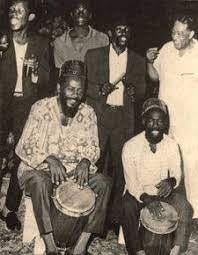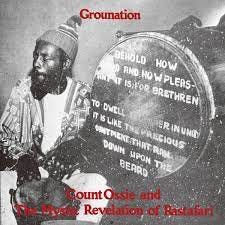The prehistory of ska, reggae and other Jamaican musics is usually traced to a Rasta encampment on the east side of Kingston. There, starting in the late 1950s, the drummer and bandleader known as Count Ossie held gatherings called grounations at which he and others would share songs and parables and sermons around a drum circle. The rhythms were drawn from Jamaican Kumina drumming – and, of course, from Africa, derived from ceremonial music of the Bantu people of Eastern Congo.
Now regarded as an originator of the niyabinghi rhythms that anchored these events, Count Ossie was an early cultural outlaw; he suffered as a result of the Jamaican music establishment’s strict ban on all Rastafarian music. The ban prevented his groups from recording and performing in public settings, and created the impression that music with this type of ritual energy was out of bounds, and possibly dangerous.
Just one thing though: People liked to dance to Count Ossie’s music. In her book The First Rasta, author Hélène Lee describes how a rumba dancer of Lebanese descent, Margarita Mahfood, changed the perception of Rasta music in Jamaica in 1959. Mahfood demanded that Ossie’s group be part of several of her highly visible Kingston performances, including a recurring talent showcase called the Opportunity Hour. She prevailed, and within weeks Count Ossie’s group was performing regularly, winning converts to its polyrhythmically intricate approach – which became foundational to ska and the abundant riches that followed.
Count Ossie continued to hold the grounation gatherings, and as his collective’s profile expanded – they appeared on numerous 45s by early ska bands – those events grew into epic cross-genre jam sessions. Among the participants was the saxophonist Cedric ‘IM’ Brooks, the leader of a jazz group known as the Mystics. The juxtaposition of Count Ossie’s steady niyabinghi hand drum patterns with Brooks’ fervent improvisations proved transformational – the ancient overtones of ritual music became invigorated, and sometimes upended, by gale-like horn freakouts and sudden flashes of extemporaneous brilliance. At times it sounds like the Sun Ra Arkestra doing a cosmic intervention at a church service.
The 1973 triple album Grounation – reissued on Dub Store Records in 2016 and available on Bandcamp – documents studio meetings between Count Ossie’s crew and Brooks’, which operated under several monikers including The Mystic Revelation of Rastafari.
This album is mindblowing for the musical history it made – and also the cultural history it contains. It shows how Count Ossie, barely a decade out from under a systemic discrimination that marginialized his art, conveyed the essence of Rastafarianism through openness and a spirit of celebration. He used repetitive cadences and sermonizing incantations to reinforce griot-like accounts of slavery and hardship – which, it must be said, sometimes stretch to epic length. And, crucially, he and Brooks exploited the hypnotic power of the rhythms, presaging the wide beats of dancehall and the dub phrasing of Lee Scratch Perry. After one of those long sermons, there inevitably comes redemption in groove form, a blast of torrid sound that can’t be tagged as “ancient” or tagged as “futurist,” but instead is profoundly both at once.
Why yes, we have a fancy digital suggestion box. Share your favorite Underloved/Overlooked records here: echolocatormusic@gmail.com.
Please consider subscribing (it’s still free!). And…..please spread the word! (This only works via word of mouth!).









Thank you Bart Miltenberger! Wow it is the same melody -- I hear the exact same route you describe! Thanks for sharing and also the kind words! And apologies for missing this earlier (was on vacation). Thank you!
Thanks for this! My mind was completely blown at around the 2/2:15 minute mark of "Grounation" from 1970. It's the same song/melody as "Zion I," the opening track on Cymande's first album from 1972. I've been a huge fan of that album for over twenty years now (Cymande is on tour btw and coming to Ardmore Music Hall on 9/22), so hearing this melody in this Grounation just shook me. It's like a cross-pollination of a cross-pollination - transatlantic Nyabinghi to Jamaica and then transatlantic Nyabinghi to London.
I'm a big fan of EchoLocator. I have a need to hear and learn about new music all the time and blog is such a fun education and inspiration for deeper dives. Thank you!
Bart